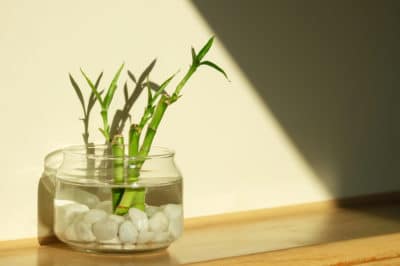True Bamboo vs. Lucky Bamboo
True bamboo is a perennial evergreen grass that ranges in size from pygmy bamboos of 18 inches in height to timber bamboos more than 100 feet tall. In the right conditions, the type called running bamboos – so-named for their growth habit of spreading by underground rhizomes – can be invasive. Lucky bamboo is actually Dracaena sanderiana, a houseplant related to Diffenbachia.
About Lucky Bamboo
The popularity of lucky bamboo may have come about for several reasons. Among these:
- Associated with feng shui, lucky bamboo is considered to bring blessings on an individual or household.
- The plant is very easy to grow and propagate.
- Lucky bamboo makes a good houseplant and can be grown in offices.
- Unlike most plants, lucky bamboo will grow in plain water.
Water or Soil
While lucky bamboo can get along for extended periods in plain water, it actually will grow better and be healthier in soil. If you choose to grow it in soil, it’s best to mix commercial potting soil half and half with coarse sand, perlite or vermiculite to promote good drainage. While lucky bamboo can handle moist soil, it still needs well-drained soil for best health.
Water Quality and Lucky Bamboo
It’s best to avoid tap water in growing lucky bamboo. The plant is sensitive to chlorine, fluoride and the chemicals used to soften hard water. Rainwater is the best choice, but if that’s not practical, you can use distilled or filtered water. Prior to changing the water in the container, pour the new water back and forth several times to oxygenate the water.
Caring for Lucky Bamboo
Lucky bamboo has a few basic requirements. Bright indirect light is best, but it cannot tolerate full sunlight for very long. Change the water and thoroughly clean the container at least every two weeks. Make sure the container is thoroughly rinsed after cleaning. Place clean marbles, glass beads or rock chips in the bottom of the container. Use one drop of liquid fertilizer once a month.
Problems with Lucky Bamboo
The most common problem with lucky bamboo is contamination and rot because the water wasn’t changed often enough. If the stems turn yellow, the plant usually won’t recover and should be discarded. Algae overgrowth may occur in clear containers. Switching to an opaque container usually solves the problem. Don’t over-fertilize – it increases algae growth and can kill the plant.
